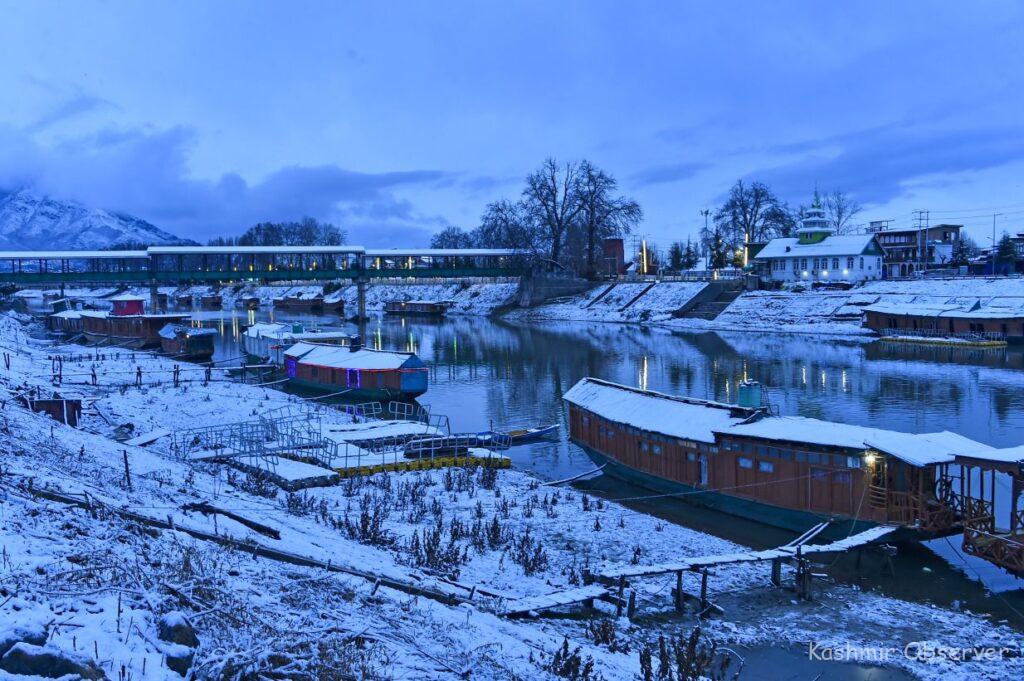
Srinagar- Despite the much-anticipated snowfall in Kashmir since last week, which ended a two-month-long dry spell, environmental experts argue that the snowfall following ‘Chillai Kalan’ will have a diminished impact, as it may not provide sufficient replenishment to address the prolonged water scarcity and environmental concerns in the region.
Kashmir witnessed the record-breaking driest Chillai Kalan this year, experiencing warmer days than ever. However, on the last day of this 40-day-long most severe part of winter, western disturbances hit, and the region received its first snowfall
Experts argue that snow less Chillai Kalan is “worrisome” given that snow and glaciers regulate stream flows and help in groundwater recharge in Kashmir.They said that the absence of snow means all the water-dependent sectors of the economy, be it irrigated agriculture, hydropower generation, and associated sectors, could be affected in the upcoming summer.
“This would also mean early snow melt of the scanty snow that is near/on glaciers and would expose glacier ice to an earlier melt (April) than usually happens (June-July),” said Irfan Rashid, Assistant Professor at the Department of Geoinformatics, University of Kashmir.
He further said that the glacier ice will get exposed and start melting earlier than usual. “This would mean higher ice loss this year,” he said.
“Pertinent to mention that glaciers have already been experiencing ice loss since the 1990s/2000s.”
Earth scientist Shakil Romshoo, the vice-chancellor of the Islamic University of Science and Technology (IUST) told Kashmir Observer that snowfall during peak of the winter stays for a longer period of time as the temperature remains in minus while as post Chillai Kalan, the snow starts melting in fast speed as the temperature increases.
“It’s good that snow has finally started but it’s watery (snow with a good amount of water) not dry. That means it will melt quickly as the snowfall in Chillai Kalan is dry and therefore remains for a long time,” he added.
He however said that it is too early to make predictions; if the valley receives ample snowfall in February, there is a possibility of compensation
Lately, climate change is making a significant impact in the Himalayan region, which is witnessing extreme weather events, prolonged dry spells in both winter and summer. The unusual weather patterns are making a significant impact on groundwater, electricity, fish production and agriculture.
Rashid said that this change in the weather pattern is driven by global climate change which affects distribution and development of the pressure belt.
“Since a low pressure system hasn’t yet developed over Kashmir this winter, we experienced a dry spell,” he added.
Director of Meteorological Centre, Srinagar, Mukhtar Ahmad however contends that this is not the first occurrence; rather, it has been a recurring pattern in the Union Territory for the past few decades.
Follow this link to join our WhatsApp group: Join Now
Be Part of Quality Journalism |
Quality journalism takes a lot of time, money and hard work to produce and despite all the hardships we still do it. Our reporters and editors are working overtime in Kashmir and beyond to cover what you care about, break big stories, and expose injustices that can change lives. Today more people are reading Kashmir Observer than ever, but only a handful are paying while advertising revenues are falling fast. |
| ACT NOW |
| MONTHLY | Rs 100 | |
| YEARLY | Rs 1000 | |
| LIFETIME | Rs 10000 | |











